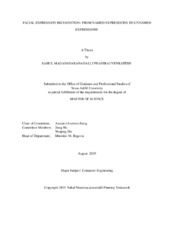| dc.description.abstract | Facial expressions plan a very important role in interpersonal relations as they convey nonverbal cues. Automatic recognition of facial expressions forms a crucial component in human-machine interfaces. The main motivation behind choosing this problem is that there are many facial expressions to recognize. It is a very difficult task to categorize them as they are very subtle. Same expressions can have different meanings for different people in different context. Facial Expression Recognition (FER) has applications across many domains like business, education, and health care. In the existing work, people mainly focus on recognizing the seven basic expressions like happy, sad, disgust, angry, surprise, neutral, and fear. In this research work, we try to explore a new direction where we try to recognize many more expressions apart from the basic seven expressions. These expressions are hard to name but exist in real life. The approach taken is One-shot learning. Every time we observe a new expression, we use one-shot learning technique to recall previous cases where same expression was seen. By doing this, people can understand in which context the same expression appears, which will lead to the understanding of each expression. In the present work, we train the neural network for the basic seven expressions.
We later extract the features from the penultimate Fully Connected (FC) layer as a feature representation for the input image. These features are used in further processing and as a basis for one-shot learning. While the current research involves 2D static images, we further extend our research from 2D expression to 3D video clips. The main reason for doing this is, expression is not a static image of the face at a given time. Actually, if we involve the change in expression in a short period of time, it is more meaningful in recognizing expression. This aspect has been less explored before. The results obtained for 2D static images show that One-shot learning performs a very good job in recognizing new expressions with just one training example. | en |


